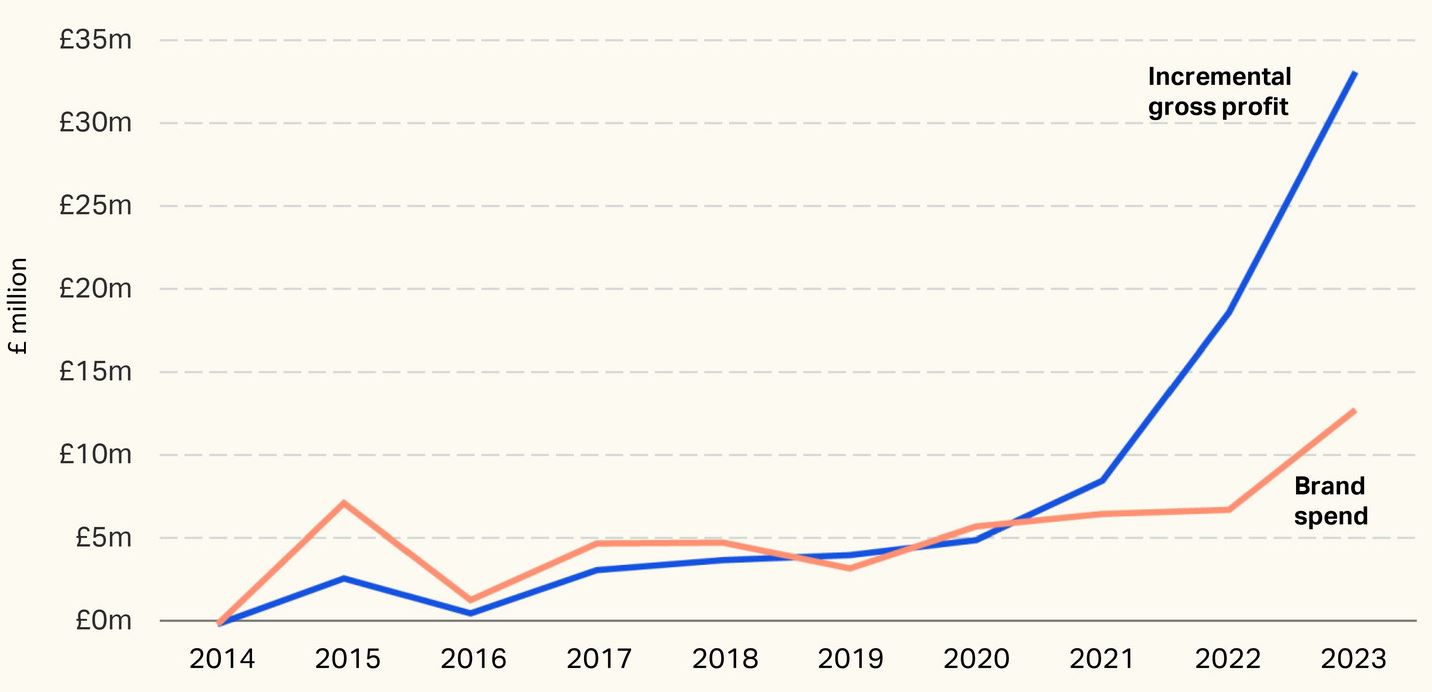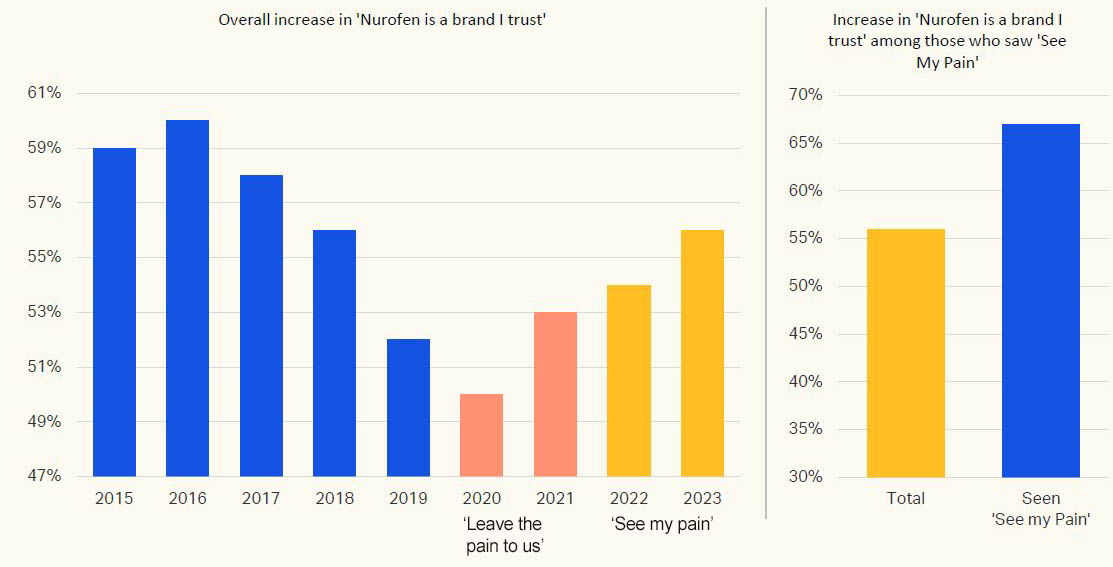From advertising to grow pricing power or trust and using testing to support the business case for brand building, Warc has picked five proven approaches others can learn from in the most recent Effectiveness Award winners.
The IPA Effectiveness Awards require incredibly detailed analysis of payback from marketing spend. And, as a result, each of the winning case studies provides a masterclass in putting effectiveness theory into practice. It’s also valuable each time the biennial competition comes around to take a step back to look at what’s changing and to find broad themes across what worked.
In a new Warc report, we explore five big themes that emerged from the 2024 IPA Effectiveness Awards and analyse the data defining how advertising effectiveness works now. There are also brief details of every winner to encourage you to identify which campaigns might be most relevant to your work and dive into the full case studies. So, what were the key features of the 2024 winners?
1. Advertising to reduce price elasticity
Winning campaigns supported brand pricing power through a focus on long-term brand building and the powerful effect that had on the bottom line of businesses – with a brilliant example of price effects detailed in the Grand Prix-winning McCain paper.
Increasingly, supporting brand pricing is cited as a reason to invest in brand building advertising. This argument also provides a useful re-framing for how to balance marketing to achieve short-term only effects and to create more sustained benefits. To lower a brand’s price elasticity, for instance, typically takes time and a brand with strong attributes in the first place. But staying the course can pay huge dividends. The analysis in the Grand Prix case stretches over ten years, and as one of the paper’s authors, Roisin Mulroney from adam&eveDDB, notes, “Most brands would have changed tack before the payback really kicked in.”
The payback from brand advertising increased exponentially

Chart source: McCain IPA Effectiveness Awards 2024 case
2. Focusing on increasing trust
Brands proved their credibility, enhanced their reputations, justified their pricing, and brought peace of mind to their customers all through a deliberate focus on trust. At a time of growing distrust in institutions and uncertainty around the impact of AI, trust is becoming an increasingly important metric for marketers.
In the crop of 2024 IPA winners, building trust underpinned emotion-led campaigns for finance and pharma brands, leading to impressive business results. Trust was also key as a consumer insight, driving behaviour change across a range of categories. Edelman research shows trust is the second most important purchasing factor after price.
One award winner that showed the importance of trust was Nurofen. After years of declining sales, accelerated by misleading guidance to avoid ibruprofen in the pandemic, Nurofen invested £3m into researching the gender pain gap (defined as “the phenomenon in which pain in women is more poorly understood and more mistreated compared to pain in men due to systemic gaps and biases”) and changed how people felt about the brand. Nurofen changed from a more rational science-driven strategy and launched a new emotion-led positioning with the empathy-driven ‘Leave the pain to us’ in 2020 and 2021. Spurred on by positive results, it then found a more purposeful way to build empathy with ‘See my pain’.
Nurofen increased trust by 67% among those who saw the 'See My Pain' campaign

Chart source: Nurofen IPA Effectiveness Awards 2024 case
3. Restoring brand growth
There were several classic brands among the winners that had found themselves less relevant and were suffering declining sales as a result. These brands were reinvigorated in several ways, with a focus on bringing marketing fundamentals into a new era. As Dom Boyd, Managing Director Kantar UK Insights, highlights, the reality is that marketers are often working on older brands, “where at every corner there’s the potential to get it badly wrong by losing focus, playing too safe or quietly stagnating into irrelevance”.
Avoiding this fate were some of the UK’s most well-known brands including Cadbury, Tesco Mobile and Müller that each took a careful look at what made its brand special and used those core brand attributes, along with emotion-driven insights and confident creative, to supercharge commercial fortunes.
4. Making smart media choices
As media fragments and consumption patterns change, winning brands have had to adapt to reach younger consumers, while others had to rethink the channel mix to reach a broader audience.
Media fragmentation is nothing new but reaching people with a consistent brand message appropriately across multiple platforms and accurately measuring the result is becoming a growing challenge. Whatever your objective there are interesting examples of adapting to the new media reality across the 2024 winners. Established brands like Guinness and the BBC made major pivots in their media strategy to connect with new audiences. H&M completely restructured its website to capture organic search traffic. And Concierge Car Wash in Australia showed how much can be achieved with one touchpoint, a sharp strategy, and a tiny budget.
5. Creating a robust business case for brand investment
Proving the case for advertising to the C Suite is a perennial challenge. These IPA papers help make that case by showing not only the value of long-term strategy, but how to put together a case to build investment over time. For example, Laithwaites proved the case for investing in brand, while also growing sales immediately. The winning approach was a programme of robust regional TV testing which unlocked more brand building budget and proved its short-term impact and ability to restore growth at the wine retailer.
Joy Talbot, Senior Director at Magic Numbers, says in the report, “It’s very hard to do great ads without proof of greatness.” For Yorkshire Tea, she notes that “With a short and longer-term measurement framework throughout the campaign, everyone in the team could see the brand’s strong performance, and stuck to their guns, with finance being confident that the ad budget was well-spent.”
That is a relationship with finance that many marketers would like to learn more about – so do spend some time with this and other winning case studies, and the whole of our report, to find inspiration to address your challenges for the year ahead.
Catherine Driscoll is Commissioning Editor EMEA of WARC
The Warc report "Insights from the 2024 IPA Effectiveness Awards" is free for IPA members to download
The opinions expressed here are those of the authors and were submitted in accordance with the IPA terms and conditions regarding the uploading and contribution of content to the IPA newsletters, IPA website, or other IPA media, and should not be interpreted as representing the opinion of the IPA.



